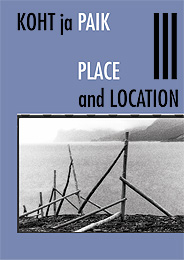She is author of The Pursuit of Pleasure, (London: Athlone Press, 2002). She is also editor of A Place Between, Public Art Journal, issue 2, (October 1999) and co-editor of Strangely Familiar: Narratives of Architecture and the City, (London: Routledge, 1995), Gender Space Architecture: An Interdisciplinary Introduction, (London: Routledge, 1999), Intersections: Architectural Histories and Critical Theories, (London: Routledge, 2000) and The Unknown City: Contesting Architecture and Social Space, (Cambridge Mass.: MIT Press, 2000).
She is currently completing A Place Between: Art, Architecture and Critical Theory, for Reaktion Press and working on a project of site specific writings entitled 'Writing Aloud'. She considers her writing to be a form of architecture, a critical spatial practice, and is exploring through research and teaching the possibilities for site specific writing. Recent work includes essays for artists and architects, such as Sharon Kivland, Jane Prophet and Hawkins/Brown and galleries, such as The Wapping Project and BALTIC, as well as text-based pieces for Brandon Labelle, Simon Morris and Brigid McLeer.

"A Place Between, Art, Architecture and Critical Theory" (PDF)
PLACE and LOCATION / Studies in Environmental Aesthetics and Semiotics III
In the last ten years a number of academic disciplines have come together in discussions concerning ‘the city’. This interdisciplinary terrain of ‘spatial theory’ has reformulated the ways in which space is understood and practiced. One of the books I am working on, A Place Between, focuses attention on the writings of such influential spatial thinkers as Michel de Certeau, Walter Benjamin, Hélène Cixous, Luce Irigaray and Rosi Braidotti. I do so to provide starting points for several speculative journeys between theory and practice. By stretching and playing out definitions like ‘art’ and ‘architecture’, theoretical reflection provides standpoints from which to explore what we might call critical spatial practice.
From "A Place Between, Art, Architecture and Critical Theory"
"Places between": three tactics in critical spatial arts
Despite current enthusiasm for interdisciplinarity, multi-disciplinarity and collaboration in art and architecture, I argue that there is still a deep-seated anxiety concerning the edges and crossing-points of disciplines. This anxiety is expressed through a tendency to make separations between different disciplines rather than connections. Making connections is necessarily a difficult business because it demands a questioning of terminologies and methodologies normally taken for granted, and a willingness to let go and to allow transformation....
Theoretical debates concerning urban culture have reformulated the ways in which we might understand the anxieties around the boundaries of disciplines as well as the potential places in which connections might be made. From cultural geography, for example, we have the notion of the ‘socio-spatial dialectic’ which suggests an inter-active relation between people and places, allowing us to consider the city as multiple sites of desire and flux. From feminist theory, we can understand the ‘internal’ space of individual subjectivity and the ‘external’ space of the urban realm to be a series of overlapping and intersecting boundaries and thresholds between private and public, inner and outer, subject and object, the personal and the social.
It is at these thresholds that many of the current debates about public art practice are located. On the oone hand, often considered to focus on their own 'private' worlds and the personal interests, artists who work in public spaces are often thought of as self- indulgent and arrogant. On the other hand, art works that attempt to relate to the ‘public’ as a particular social group or number of individuals who identify with one another, have often been criticised as simplistic and patronising. These kinds of ambivalent attitudes that respond to the placing of 'private' art outside the gallery in 'public' urban sites, raise important questions about the definitions, inter-relations and boundaries of the term public art.
The paper goes on to look at three modes of contemporary critical public art that help us to explore places between spatial theory and practice and between public and private....
Tate Modern / Making Public Seminar
Rosalyn Deutsche / Jane Rendell / Gillian Rose
The second event in the Making Public series centres on how publicness emerges in art and art writing.
Since her book Evictions (1996), Rosalyn Deutsche (Barnard College and Columbia University, New York) has become widely recognised as one of the foremost thinkers in connection with the relationships between contemporary art and the politics of space. Jane Rendell (Bartlett School of Architecture, UCL) has written extensively on gender, space, architecture and urbanism. She is currently working on the relationship between public and private voices in the practice of art criticism, especially in its confessional mode. Gillian Rose is Professor of Geography at the Open University, and has written extensively on gender and the public and private uses of visual images. She has also researched the impact of public art.
The academy for practice-based research in architecture and design (AKAD)
Writing Architecture is a course and series of workshops offered by AKAD, through Katja Grillner, at KTH. The project is shown at the AKAD exhibition at Lund Konsthall in january 2006. It shows the texts - stories, poems, collages, essays – which were written in the course, as well as film and photographs from the events. These workshops seek to raise the awareness of language and writing in relation to architectural and spatial explorations. Architects, designers, artists and researchers have been invited to explore their own textual modes of expression and develop critical modes of reading and discussing texts. Text and language are here regarded as design materials among others, and as unique tools for formulating and communicating critically the insights gained through an experimental research by design project.
"Travelling The Distance/Encountering Others" (PDF)
"Writing in place of speaking" (PDF)